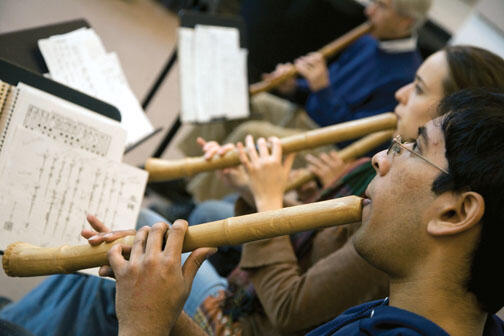Exploring the Zen flute; voting in favor of service
Protruding out of Lauren Ledley ’10’s backpack — crammed with textbooks, papers, pencils — is a flared flute, almost two feet long, with a plastic body resembling bamboo. In classes, Ledley’s peers don’t know what to make of it.
The flute is called a shakuhachi. Its history traces back through centuries of Japanese Zen Buddhist practices. Ledley, an anthropology major, is one of 23 students partaking in what is believed to be the first academic course — not just at Princeton, but at any university in the world — devoted to the shakuhachi. “Masterworks for the Zen Flute” is co-taught by comp-lit professor Thomas Hare ’75 and visiting fellow Riley Lee, acclaimed as the first non-Japanese shakuhachi grand master.
The shakuhachi is not an instrument attempted lightly. “I had no idea it would take a whole month to make a sound!” exclaims Ledley. As Lee explains, the shakuhachi is very much about “delayed gratification.” But with skill, it ripples melancholy and breathy tones.
It is impossible to recapture the sound of the ancient shakuhachi, Hare explains. Although the Zen priests recorded the notes, the same score can sound completely different, depending upon the embellishments used.
During weekly music lessons, students furiously scribble elaborations to their musical notation: a headshake here, slide your finger from the bottom up there — each nuance alters the sound.
Hare and Lee encourage their students not to limit themselves to the music. Just as Zen Buddhism strives to heighten awareness of the larger surroundings, Lee hopes to nourish a broad understanding of the shakuhachi. Students pore over pictures, prints, verses, stories; they examine how the flute was held, where it was played, how it looked. Ledley predicts that this course will stay with her long after graduation.
Each class opens with a private performance. Lee’s voice lilts. “We are in a temple. There are tatami mats on the floor.” A student’s cell phone rings. “You can hear birds chirping,” he adds with the hint of a smile. “There is a figure before you, dressed in a kimono.” Eyes closed, Lee begins to play.
By Alice Lloyd George '09
After a lively campus debate, students in late April chose to take $60,000 that had been designated for a fall lawnparties concert and spend it instead on student-initiated service projects. An option to donate the money to Annual Giving was soundly defeated.
Deciding a second question on the Undergraduate Student Government ballot, students voted to redirect another $20,000 from the Senate Pilot Programs budget to service projects. The work will be coordinated by the Pace Center.
“I think it’s fantastic that this money is going to give undergraduates more opportunities to help outside communities that are being hit severely by the economic downturn,” said USG president Connor Diemand-Yauman ’10, who had proposed the two questions. “This money will allow undergraduates to break through the orange bubble in a time when outside communities need it most.”
Much of the debate centered on whether the USG-sponsored fall lawnparties concert should be canceled.
“I don’t object to making some changes around campus, but I know there are better ways to go about it than immediately attacking one of the school’s most cherished traditions,” said Travis Erdman ’11, creator of the “Save Lawnparties!!” Facebook group.
At an April 22 student forum to discuss the issue prior to the referendum, Kelley Taylor ’11 said the fall concert is important as an alcohol-free event where all students can feel comfortable, adding that the funds would be only a drop in the Annual Giving bucket.
Other students argued that to sacrifice a popular event on behalf of Annual Giving would be a powerful gesture. “We’re Princeton undergraduates, we have benefited from a lot of things the University has done, and this is our way of giving back directly,” David Kurz ’12 said.
Provost Christopher Eisgruber ’83 had voiced support for reallocating the USG funding to Annual Giving, saying it would “have a leveraging impact far beyond any other $60,000 contribution we can get.” On both referenda, however, retaining the funds for their original purpose was second in the voting, while donating the funds to Annual Giving was the least-favored option.













No responses yet